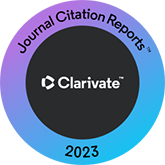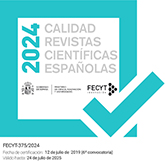L2 rhythm acquisition and rhythmic transfer in Galician learners of English: A pilot study
DOI:
https://doi.org/10.3989/loquens.2022.087Keywords:
Rhythmic transfer, L2 rhythm learning, English rhythm, rhythm metricsAbstract
Languages have been classified with regard to their rhythm into stress-timed, syllable-timed and mora-timed languages. The aim of this pilot study is to verify the existence of rhythmic transfer from a syllable-timed language, Galician (L1), to the English spoken by Galician learners (L2), as well as to determine whether the proficiency level in the L2 may have an effect on the degree of rhythmic transfer observed. Two groups of six Galician learners of English and two groups of six native speakers of Galician and Southern British English were recorded and analyzed. Rhythm metrics (ΔC, %V, ΔV, CrPVI, and VnPVI) were calculated for all four groups so as to have objective measures to compare the rhythm of the source language (Galician), the rhythm of the target language (English), and the rhythm of the learner language at different proficiency levels. The data show that there is rhythmic transfer between Galician and English L2, and that the degree of transfer decreases as the proficiency level in the L2 increases.
Downloads
References
Abercrombie, D. (1967). Elements of General Phonetics. Edinburgh: Edinburgh University Press.
Arvaniti, A. (2012). The usefulness of metrics in the quantification of speech rhythm. Journal of Phonetics, 40, 351-373. https://doi.org/10.1016/j.wocn.2012.02.003
Arvaniti, A. (2009). Rhythm, timing and the timing of rhythm. Phonetica, 66(1-2), 46-63. https://doi.org/10.1159/000208930 PMid:19390230 PMCid:PMC2790788
Bertinetto P.M. (1989). Reflections of the dichotomy "stress" vs. "syllable-timing". Revue de Phonétique Appliquée, 91-93, 99-130.
Boersma, P. & Weenink, D. (2019). Praat: Doing phonetics by computer [Computer program]. Version 6.1.07, retrieved from http://www.praat.org/
Bond, Z.S. & Fokes, J. (1985). Non-native pattern of English syllable-timing. Journal of Phonetics, 13, 407-420. https://doi.org/10.1016/S0095-4470(19)30786-7
Broselow, E. & Kang, Y. (2013). Second language phonology and speech. In Herschensohn, J. & M. Young-Scholten (Eds.), The Cambridge Handbook of Second Language Acquisition (pp. 529-554). Cambridge: Cambridge University Press. https://doi.org/10.1017/CBO9781139051729.031
Brown, H. (2000). Principles of Language Learning and Teaching. London: Pearson Education.
Bunta, F. & Ingram, D. (2007). The acquisition of speech rhythm by bilingual Spanish- and English-speaking 4- and 5-year-old children. Journal of Speech, Language, and Hearing Research, 50(4), 999-1014. https://doi.org/10.1044/1092-4388(2007/070) PMid:17675601
Celce-Murcia, M. (Ed.) (1991). Teaching English as a Second or Foreign Language (2nd ed.). Boston, MA: Heinle & Heinle Publishers.
Council of Europe. (2001). Common European framework of reference for languages: Learning, teaching, assessment. Cambridge: Press Syndicate of the University of Cambridge.
Dauer, R. (1983). Stress-timing and syllable-timing reanalyzed. Journal of Phonetics, 11, 51-62. https://doi.org/10.1016/S0095-4470(19)30776-4
Dellwo, V. (2006). Rhythm and Speech Rate: A Variation Coefficient for deltaC. In P. Karnowski & I. Szigeti (Eds.), Language and Language-processing (pp. 231-241). Bern: Peter Lang.
Eckman, F.R. (2012). Second language phonology. In S. M. Gass & A. Mackey (Eds.), The Routledge Handbook of Second Language Acquisition (pp. 91-105). London: Routledge.
Espinosa, G.E. (2019). English speech rhythm in instructed learners. Its development as shown by VarcoV. In G. E. Espinosa, M. Fernández Beschtedt, P. A. Formiga, & M. A. Verdú (Eds.), Conocimiento y diversidad en el estudio y la enseñanza de lenguas, Neuquén: Universidad Nacional del Comahue (pp. 204-212). Retrieved from http://bibliotecadelenguas.uncoma.edu.ar/items/show/426
Espinosa, G.E. (2018). La adquisición del ritmo inglés por hablantes nativos de español. El caso de aprendientes argentinos en contexto de instrucción formal [Unpublished PhD thesis]. Buenos Aires: Universidad de Buenos Aires, Argentina.
Flege, J.E., Schirru, C., & MacKay, I.R.A. (2003). Interaction between the native and second language phonetic subsystems. Speech Communication, 40, 467-491. https://doi.org/10.1016/S0167-6393(02)00128-0
Gabriel, C., & Kireva, E. (2014). Speech rhythm and vowel raising in Bulgarian Judeo-Spanish. In N. Campbell, D. Gibbon, & D. Hirst (Eds.), Proceedings of Speech Prosody 2014 (pp. 728-732). https://doi.org/10.21437/SpeechProsody.2014-134
Gass, S.M. & Selinker, L. (2008). Second Language Acquisition: An Introductory Course (3rd edition). London: Routledge. https://doi.org/10.4324/9780203932841
Grabe, E. & Low E.L. (2002). Durational variability in speech and the rhythm class hypothesis. In C. Gussenhoven & N. Warner (Eds.), Papers in Laboratory Phonology 7 (pp. 515-546). Berlin: De Gruyter. https://doi.org/10.1515/9783110197105.2.515
Grenon, I. & White, L. (2008). Acquiring rhythm: A comparison of L1 and L2 speakers of Canadian English and Japanese. Proceedings of the 32nd Boston University conference on language development (pp. 155-166). Boston: Boston University.
Gutiérrez Díez, F., Dellwo, V., Gavaldà, N., & Rosen, S. (2008). The development of measurable speech rhythm during second language acquisition. The Journal of the Acoustical Society of America, 123. https://doi.org/10.1121/1.2935815
Gut, U. (2012). Rhythm in L2 speech. Speech and language technology, 14/15, 83-94.
IPA (1999). Handbook of the International Phonetic Association. A Guide to the Use of the International Phonetic Alphabet. Cambridge: Cambridge University Press.
James, A. (1988). The Acquisition o f a Second Language Phonology. Tübingen: Narr.
Kennedy, S. & Trofimovich, P. (2010). Language awareness and second language pronunciation: A classroom study. Language Awareness, 19, 171-185. https://doi.org/10.1080/09658416.2010.486439
Kinoshita, K. & Sheppard, C. (2011). Validating acoustic measures of speech rhythm for second language acquisition. In W. S. Lee & E. Zee (Eds.), Proceedings of the 17th International Congress of Phonetic Sciences (pp. 1086-1089). Hong Kong: City University of Hong Kong.
Kireva, E. & Gabriel, C. (2015). Rhythmic properties of a contact variety: Comparing read and semi-spontaneous speech in Argentinean Porteño Spanish. In M. Avanzi, E. Delais-Roussarie & S. Herment (Eds.), Prosody and Languages in Contact (pp. 149-168). Berlin: Springer. https://doi.org/10.1007/978-3-662-45168-7_8
Kohler, K.J. (2009). Rhythm in speech and language. Phonetica, 66(1-2), 29-45. https://doi.org/10.1159/000208929 PMid:19390229
Leather, J. & James, A. (1991). The acquisition of second language speech. Studies in Second Language Acquisition, 13, 305-341. https://doi.org/10.1017/S0272263100010019
Li, A. & Post, B. (2014). L2 acquisition of prosodic properties of speech rhythm: Evidence from L1 Mandarin and German learners of English. Studies in Second Language Acquisition, 36(2), 223-255. https://doi.org/10.1017/S0272263113000752
Mairano, P. & Romano, A. (2010). Un confronto tra diverse metriche ritmiche usando Correlatore. In S. Schmid, M. Schwarzenbach, & D. Studer (Eds.), La dimensione temporale del parlato (pp. 79-100). Bern: EDK.
Major, R.C. (2008). Transfer in Second Language Phonology - A review. In J. G. Hansen Edwards & M. L. Zampini (Eds.), Phonology and second language acquisition, Studies in Bilingualism (pp. 63-94). Amsterdam: John Benjamins. j https://doi.org/10.1075/sibil.36.05maj
Ordin, M. & Polyanskaya, L. (2014). Development of timing patterns in first and second languages. System, 42, 244-257. https://doi.org/10.1016/j.system.2013.12.004
Ordin, M. & Polyanskaya, L. (2015a). Acquisition of speech rhythm in a second language by learners with rhythmically different native languages. The Journal of the Acoustic Society of America, 138(2), 533-545. https://doi.org/10.1121/1.4923359 PMid:26328670
Ordin, M. & Polyanskaya, L. (2015b). Acquisition of English speech rhythm by monolingual children. In INTERSPEECH-2015 (pp. 3120-3124). https://doi.org/10.21437/Interspeech.2015-628
Payne, E., Post, B., Astruc, Ll., Prieto, P. & Vanrell, M.M. (2012). Measuring child rhythm. Language and Speech, 55(2), 203-229. https://doi.org/10.1177/0023830911417687 PMid:22783632
Pike, K. (1945). The Intonation of American English. Ann Arbor, MI: University of Michigan Press.
Polyanskaya, L., Ordin, M., & Busa, M.G. (2016). Relative salience of speech rhythm and speech rate on perceived foreign accent in a second language. Language and Speech, 60(3), 333-355. https://doi.org/10.1177/0023830916648720 PMid:28915779
Prieto, P., Vanrell, M.M., Astruc, Ll., Payne, E., & Post B. (2012). Phonotactic and phrasal properties of speech rhythm. Evidence from Catalan, English, and Spanish. Speech Communication, 54(6), 681-702. https://doi.org/10.1016/j.specom.2011.12.001
Ramus, F. (2002). Acoustic correlates of linguistic rhythm: Perspectives. In B. Bel & I. Marlien (Eds.), Proceedings of Speech Prosody 2002 (pp. 115-130). Aix-en-Provence: Université de Provence.
Ramus, F., Nespor, M., & Mehler, J. (1999). Correlates of linguistic rhythm in the speech signal. Cognition, 73, 265-292. https://doi.org/10.1016/S0010-0277(99)00058-X PMid:10585517
Rasier, L. & Hiligsmann, Ph. (2007). Prosodic transfer. Theoretical and issues. Nouveaux cahiers de linguistique Franτaise, 28, 41-66.
Rathcke, T.V. & Smith, R.H. (2015). Speech timing and linguistic rhythm: On the acoustic bases of rhythm typologies. The Journal of the Acoustical Society of America, 137(5), 2834-2845. https://doi.org/10.1121/1.4919322 PMid:25994711
Roseano, P. (2021). Splitting the rhythmic continuum in rhythmic classes: An HCA approach [Poster presentation]. 4th Phonetics and Phonology in Europe (PaPE), June 21-23. Barcelona, Spain.
Ross, T., Ferjan, N., & Arvaniti, A. (2008). On the reliability of rhythm metrics. The Journal of the Acoustical Society of America, 124, 2495. https://doi.org/10.1121/1.4782810
Ryu, Y. (2002). Pronunciation of English as a second or foreign language learners [sic]: the reexamination of teaching pronunciation [Unpublished MA dissertation]. Missoula, USA: The University of Montana.
Scovel, T. (1988). A Time to Speak: A Psycholinguistic Inquiry into the Critical Period for Human Speech. Cork, Ireland: Newbury House.
Scovel, T. (1969). Foreign accents, language acquisition and cerebral dominance. Language Learning, 25, 209-235.
Tsiartsioni, E. (2011). Can pronunciation be taught? Teaching English speech rhythm to Greek students. In E. Kitis, N. Lavidas, N. Tpointzi, & T. Tsangalidis (Eds.), Proceedings of the 19th International Symposium on Theoretical and Applied Linguistics (ISTAL) (pp. 447-458). Tesalonica: Aristotle University of Thessaloniki.
Van Maastricht, L., Krahmer, E., Swerts, M., & Prieto, P. (2019). Learning direction matters: A study on L2 rhythm acquisition by Dutch learners of Spanish and Spanish learners of Dutch. Studies in Second Language Acquisition, 41(1), 87-121. https://doi.org/10.1017/S0272263118000062
Wenk, B. (1986). Crosslinguistic influence in sound language phonology: Speech rhythms. In E. Kellerman & M. Sharwood Smith (Eds.). Crosslinguistic Influence in Second Language Acquisition (pp. 120-133). Oxford: Pergamon Press Ltd.
White, L. & Mattys, S.L. (2007a) Rhythmic typology and variation in first and second languages. In P. Prieto, Mascaró, & M.J. Solé (Eds.) Segmental and Prosodic Issues in Romance Phonology (pp. 237-257). Amsterdam: John Benjamins. https://doi.org/10.1075/cilt.282.16whi
White, L. & Mattys, S.L. (2007b). Calibrating rhythm: First language and second language studies. Journal of Phonetics, 35(4), 501-522. https://doi.org/10.1016/j.wocn.2007.02.003
Published
How to Cite
Issue
Section
License
Copyright (c) 2023 Consejo Superior de Investigaciones Científicas (CSIC)

This work is licensed under a Creative Commons Attribution 4.0 International License.
© CSIC. Manuscripts published in both the print and online versions of this journal are the property of the Consejo Superior de Investigaciones Científicas, and quoting this source is a requirement for any partial or full reproduction.
All contents of this electronic edition, except where otherwise noted, are distributed under a Creative Commons Attribution 4.0 International (CC BY 4.0) licence. You may read here the basic information and the legal text of the licence. The indication of the CC BY 4.0 licence must be expressly stated in this way when necessary.
Self-archiving in repositories, personal webpages or similar, of any version other than the final version of the work produced by the publisher, is not allowed.














